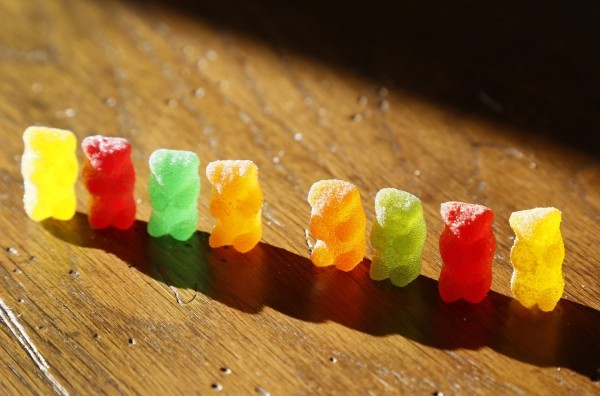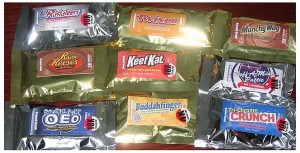Proposed Colorado law would ban marijuana products shaped like animals, humans, fruit

Colorado law aims to ban animal-shaped pot products like these (Reuters photo).
A Colorado bill aimed at protecting kids from marijuana edibles that are easily confused with candy passed the House Business Affairs & Labor Committee on Tuesday.
HB16-1436, sponsored by Reps. Dan Pabon and Joann Ginal, requires the Marijuana Enforcement Division of the Colorado Department of Revenue to draft rules that prohibit edible medical and retail marijuana products shaped like a human, animal or fruit. The bill has the support of Gov. John Hickenlooper, who highlighted his concern with edibles in his State of the State speech in January.
“This is a commonsense bill to protect our kids,” said Rep. Pabon, D-Denver. “Voters passed Amendment 64 in 2012, but what they didn’t allow was a very specific product that is easily confused as candy by children.”
“Marijuana products are designed for adults and we are asking that these products don’t mimic products marketed to children,” said Rep. Ginal, D-Fort Collins. “It’s a smart, reasonable approach to protecting Colorado children.”
An amendment was passed to clarify that geometric shapes with fruit flavors are permissible under the bill. The 10-2 vote sends the bill to the House floor for second reading.
The following is a 2015 article on legal marijuana and kids in Colorado, produced by Rocky Mountain Post for The Parents Handbook Magazine:
Legal in Eagle County: Talking to your kids about marijuana in Colorado’s new cannabis culture
It doesn’t matter who you’re talking to in Colorado these days – or even outside of the state – the topic of pot will come up. There is a fascination with the state’s legalization of recreational marijuana in 2014 that borders on obsession. And don’t think your kids aren’t listening.
Children at a very early age begin to pick up on what all the adults are talking about, especially if it’s the first question out of the mouth of your van driver on the way to Universal Orlando Resort in Florida,. My wife and I and our three boys experienced that on a recent trip, politely deflecting his questions about all those “wild-eyed stoners out in Colorado.”
The fact is, no matter how you voted on 2012’s Amendment 64 – which led to Colorado in 2014 becoming the first state in the nation to begin legal sales of recreational marijuana – very little has changed. And then again everything has changed. One pot shop employee compared it to the end of the Prohibition on alcohol in 1933. It was just four years later that the federal government first began passing laws that criminalized marijuana consumption.
Virtually since the inception of the Colorado ski industry, but especially during its boom in the 70’s and 80’s, Rocky Mountain High has had at least two meanings. Vail’s old Vistabahn bubble chairlift recently replaced by Gondola One used to be referred to, with a wink and a nod, as the “Rastabahn” for the clouds of smoke that wafted from it like the crowd at a Bob Marley concert.
Weed has been de facto legal in ski towns for decades. Police, for the most part, looked the other way, and a one-hitter or a joint was as standard a piece of ski equipment as a bota bag full of wine. It’s still illegal to smoke legally purchased pot in public, especially on U.S. Forest Service land leased from the feds by most of the state’s ski areas. Still, that skunky smell persists.
Some tourists from more conservative parts of the country are stunned at the open display of what has been taboo for most of the 20th century and the first decade of the 21st century. And a lot of them are even more shocked to see actual stores in Eagle-Vail and Eagle openly selling pot. But what really sends some folks over the edge is how everybody is talking about it.
That’s where the kids come in. They hear everything. The stories on the local news. The arguments around the dinner table. The constant questions from out-of-towners fascinated by this new phenomenon. And as much as they’ll tell you they have no interest in disgusting adult habits, many kids of a certain age can’t wait to sneak their first cigarette, tentatively sip their first beer, or … eat their first edible pot product.
Unquestionably, even though marijuana has always been around and could be acquired by any truly enterprising and curious teenager for decades, it’s now much more accessible in Colorado – if for no other reason than a 21-year-old Colorado resident can go into any local pot shop and legally buy up to an ounce. Then he or she can illegally sell or share it with friends under 21.
The question for parents then, in one of the four states – Colorado, Alaska, Oregon and Washington, plus Washington, D.C. – that have voted to legalize recreational marijuana (as opposed to medical marijuana, which is legal in 23 states and D.C.) is how do I talk to my kids about pot when it’s all the rage? And how do I keep them from consuming it, breaking the law and possibly impairing their brain development before they’re 21?
That, in and of itself, is a tricky question. There are varying studies on the extent to which marijuana consumption can impair the healthy development of an adolescent brain. But no matter what your experiences tell you from your own possibly wayward youth, most at least minimally responsible parents agree that letting your kids lie around smoking pot all day in the basement is a bad idea. Just like you wouldn’t let them drink excessively, or take pills.
So The Parents Handbook set out to explore these sticky issues, and three words kept coming up no matter who we interviewed – from law enforcement to healthcare professionals to addiction counselors to marijuana retailer. They all urged parents to be honest, open and informed.
‘It’s not just about marijuana’
“Most importantly, it needs to be an open conversation,” said Deputy Megan Richards, a school resource officer with the Eagle County Sheriff’s Office. “Because once we start that open conversation, marijuana’s going to come up, but so are a lot of things that are great opportunities for a parent to have conversations with their kids about.”
In many ways, says Richards and other experts, the pot conversation needs to be the same one parents have with kids about other things that are illegal or inadvisable under the age of 21.
“It’s not just about marijuana,” Richards said. “It could be about prescription drugs. It could be about unprotected sex. It could be about drinking and driving. It’s about teaching our kids how to make appropriate, healthy choices for themselves when they’re given options to be destructive.”
Dena Southerlan, MSW, a certified substance abuse counselor with Rocky Mountain Counseling in Eagle, says that for children and families in Colorado it doesn’t matter that recreational marijuana is now legal for adults over the age of 21.
“Whether or not marijuana is legal for those 21 years and older, I feel that is irrelevant,” Southerlan said. “A lot of times I will use nicotine as an example. This is a legal drug, and the evidence with nicotine very clearly shows how dangerous that drug is for all individuals. It is clearly the responsibility of the parents to educate and guide their children.”
And part of that education, Southerlan says, center on just how harmful excessive marijuana consumption can be in the teen years.
 “The overwhelming amount of research that has been done on the effects of marijuana on a child’s development focuses on the probability of future problems and the fact that the most commonly used gateway drug is marijuana – hands down,” Southerlan said.
“The overwhelming amount of research that has been done on the effects of marijuana on a child’s development focuses on the probability of future problems and the fact that the most commonly used gateway drug is marijuana – hands down,” Southerlan said.
She also sees pre-teen and teenaged pot smokers suffering from paranoia, anxiety, depression and general demotivation that impacts their ability to perform well in school, both academically and athletically.
Nick Brown, owner of High Country Healing and its seven retail and medical marijuana outlets in Silverthorne, Colorado Springs and Alma (near Breckenridge), agrees that parents need to be completely open to discussing the potentially harmful effects of marijuana with their kids.
“There’s a lot more money going to research to show what cannabis is doing to the health systems of human beings, and really the main finding anyone has found on the negative side is that it potentially does alter the brain growth in adolescent children,” Brown said.
However, the former Woodland Park High School standout and Princeton economics graduate adds that he’s living proof that some marijuana myths simply don’t stand up to scrutiny.
“I’ve consumed cannabis the majority of my life – I’m 32 years old – and I’ve never done a hard drug in my life,” Brown said. “It’s been the opposite of a gateway drug for me. I was actually the Colorado Football Player of the Year in high school and then I ended up playing football at Princeton for four years while consuming cannabis the whole time. I graduated in four years.”
But Brown knows everyone is different, and he acknowledges that habitual use of cannabis can inhibit the motivation of adolescents. He also knows that teenagers can and will get marijuana if they really want it.
“It’s going to be out there just like alcohol is,” Brown said. “Children are going to find one way or another to try to get it, and they’re going to get it, so trying to help them understand what happens to you when you consume it in different ways is a good idea to start talking about.”
For instance, the proliferation of edible marijuana products – many of which look just like normal cookies and candies – has been a game-changer.
“It’s really hard to ‘overdose’ on smoking pot,” Brown said. “You generally can’t smoke yourself to the point where you think you’re going to die. But if you eat too much of an edible and you don’t know what you’re doing, I’ve heard people say, ‘I thought I was going to die.’”
So information about dosages, what types of edibles are out there and how they can affect kids is critical, Brown said. “Parents obviously want to teach their children the same beliefs they have, so whether they’re pro cannabis or against cannabis, they should try to get the facts out to them.”
‘I survived it; it’s no big deal’
Many parents in their 40’s or 50’s who have been in the Vail Valley for 15 or 20 years came here to enjoy a ski-town lifestyle. Besides outdoor recreation – hard-charging on skis and mountain bikes — that lifestyle often came with some hard-charging in bars and clubs. And in addition to rivers of beer, Jaeger and tequila shots, that after-hours activity may have included marijuana or even harder drugs. Now the ski bums have grown up and have little park rats of their own.
Deputy Richards encourages complete honesty with your kids when it comes to past drug use – just don’t glorify that past by emphasizing the partying or dismissing its impacts.
“I hear that a lot from parents,” Richards said. “‘I survived it; it’s no big deal. I’m successful. I own my own business. I’m making six figures.’ Whatever their success story turned out to be, that’s great — wonderful. And I would agree that just because you dabble or experiment doesn’t mean that you become a junky. We need to be real clear about that.
“But, 80 to 90 percent of adult addictions begin in the teenage years, so why would we not encourage our kids to stay away from it?” Richards added. “Your brain and your body are growing and developing at astronomical rates. Why would you mess with that long-term?”
Family drug counselor Southerlan concurs.
“It does become an issue for some parents if they have used marijuana in the past or if they’re currently using it. It’s important for parents who have used marijuana to … look honestly at their previous drug use and ask what possible health effects they could have faced.”
Richards adds that parents need to go into retail marijuana stores and do their homework, learning the lingo, familiarizing themselves with the products and becoming educated on the potency of today’s pot.
“The THC [tetrahydrocannabinol, the psychoactive ingredient of marijuana] content in the 60’s and 70’s was anywhere from 2 to 4 percent, and it’s upwards now, commonly, of anywhere from 20 to 60 percent, and you can get almost pure THC with the dabs,” Richards said. “We have high-school-aged kids who are being consumed by those dabs right now.”
Sold legally at local retail stores, dabs are a form of hash oil made with butane and smoked through a special pipe that can deliver in excess of 90-percent THC content. One local pot shop “budtender” (yes, that’s really what they’re called) called dabs the “crack cocaine of marijuana.”
Such potency couldn’t really be found at the Dead shows of the 80’s or even the Phish shows of the 90’s. For that reason, Richards implores parents to educate themselves and then educate their kids.
“It’s wonderful if you’ve got a parent who’s able to say, ‘Yes, I used. I made really poor choices. Here are some of the pitfalls of my choices and what I had to live with,’” Richards said. “Not all parents are going to have those stories.”
Grant Troeger, retail manager at the marijuana retail store Native Roots in Eagle-Vail, encourages parents to come in and see what the buzz is all about.
“Come in here, see what it’s like, ask us questions,” Troeger said. “We’re here for people; otherwise we’d just have a vending machine. The whole point of having a staff here is to be knowledgeable and to share. That would be my advice to parents is to come in here and educate yourself and share [information] with your kids.”
To shun or ignore the stores is to embrace ignorance and invite misinformation, Troeger adds.
“The most important thing nowadays is to not deny the fact that it is legal now and it should be addressed in terms of education compared to shunning it and saying, ‘This is terrible thing,’” Troeger said. “We’ve had the police departments come in here, the fire department. We spend time with people. People want to know, and that’s our job.
“The point of having a legal store and having people like us here is to educate people so they’re not buying it on the street and getting something that they don’t know what it is. We’ve even talked about having education awareness night for parents who are concerned.”
In-home drug testing
But besides education and honest and open communication, it’s a good idea to know who your kids’ friends are and the values and rules practiced by those friends and their parents, Richards says. Finally, look for obvious and not-so-obvious signs of drug use, such as red eyes, the smell of pot smoke, money issues and a drop in performance at school.
Richards is one of about 180 certified drug-recognition experts in the state of Colorado – a designation put in place to enforce new drug driving laws but also useful in the hallways and parking lots of local schools.
A mother of four whose oldest child is 12, Richards practices and recommends random, in-home urine tests for kids when they’re old enough to start being out on their own with friends who may use drugs.
“I advocate home drug testing, not as a punishment, but as an out for kids who may otherwise have a difficult time saying no to their peers,” Richards said. “It’s a wonderful opportunity to be able to say, ‘You know, my parents drug test me occasionally, and you don’t even want to know what’s going to happen when they find me positive for THC or cocaine or whatever it may be. My dad’s going to take away my car or my mom’s going to lose her mind.’”
Urine tests can be purchased online or at Walmart or other stores, and Richards recommends random, periodic testing so kids can’t figure out the timing to beat the tests and because the tests can only determine consumption that’s metabolized in the system over time as opposed to recent use. She also suggests starting the process before you suspect there’s a problem.
“If parents choose to go that route, what I suggest is again having that open conversation,” Richards said. “A lot of parents are concerned about [testing] because they feel it violates trust. It can depending on how it’s brought into the home and how it’s used. But it’s also a great tool as an out for kids and also for parents being able to verify they’ve placed trust appropriately.”
Southerlan agrees with the in-home testing approach.
“It’s excellent because the parent in that scenario is very clear and consistent about their views on marijuana and what will and won’t be tolerated,” Southerlan said. “On the other hand, I think that you need to have the lines of communication open.”
Again, she says it’s an individual choice that may not work with all families, but that if it’s portrayed properly – as a positive rather than punitive measure – testing can keep a kid’s head in the game both academically and athletically.
“You certainly don’t want to do anything that pushes your kids away, that closes down the lines of communication,” Southerlan said. “You want them to be able to tell you the truth about what’s going on, and so [testing] is an individual choice, and each family is going to need to make the decision as to whether that’s the right choice for them.”
And that should apply to any and all steps taken to monitor, prevent and mitigate the impacts of drug use among adolescents. The one nonnegotiable factor, however, that all experts seem to agree on, is the need for honest, open dialogue with your kids.
Seeking help
A partnership between the Eagle County Sheriff’s Office and the Eagle County School District, the School Resource Officer program includes two deputies who work in the local schools as police, teachers and counselors.
Deputy Megan Richards
970-376-7058
megan@sheriff.eagle.co.us
Deputy Tad Degen
970-376-7052
tad@sheriff.eagle.co.us
For more information, go the Sheriff’s Office website at http://www.eaglecounty.us/sheriff/patrol/school_resource_officers/
Psychotherapist Dena Southerlan, MSW, is a certified substance abuse counselor with Rocky Mountain Counseling in Eagle. Go to their website at www.rockymtncounseling.com, call 970-445-2700 or email Dena at dsoutherlan@aol.com.
Southerlan recommends a Web article entitled “How to know if your teenage child is using marijuana,” which lists telltale signs such as an obvious odor, unexplained methods of masking odors, bloodshot eyes, hidden stashes or edible items. It also includes looking for signs such as money problems or missing household items sold to pay for pot. Find the article online at http://www.wikihow.com/Know-if-Your-Teenage-Child-Is-Using-Marijuana
Get educated
Native Roots in Eagle-Vail will walk concerned parents through the various products for sale at their stores and others in Eagle County. They are considering hosting parent nights for educational purposes, and local law enforcement officials recommend parents familiarize themselves with the products and lingo of the retail marijuana industry.
Native Roots
41290 U.S. Highway 6, Unit #5, Eagle-Vail
Call 970-470-4079 or go to the Native Roots website at http://www.nativeroots303.com/.
Know the law
Here’s a quick primer on Colorado marijuana laws from the official State of Colorado website at https://www.colorado.gov/pacific/marijuanainfodenver/residents-visitors.
- You must be 21 and older to buy, possess or use retail marijuana. It is illegal to give or sell retail marijuana to minors.
- Only licensed retail marijuana stores may sell retail marijuana, and only to those 21 and older.
- Retail marijuana is intended for private, personal use in certain locations not open or accessible to the public. Marijuana may not be consumed openly or publicly.
- Colorado residents 21 and older can purchase and possess up to 1 ounce of retail marijuana at a time. Non-residents can purchase up to a quarter ounce at a time.
- It is illegal to consume marijuana in or around a licensed store. It is also illegal to smoke at indoor-but-public locations such as bars, restaurants and common areas in buildings.
- marijuana “social clubs” or “coffee shops” are illegal under Colorado law.
- Penalties for violating any of these laws range from a fine to a possible jail or prison sentence. Colorado State Statutesand Denver Revised Municipal Code spell out the specific penalties for various violations.
- Schools, universities and employers are allowed to put in place their own disciplinary actions for marijuana-related infractions.
- Possession laws are the same for all retail marijuana types, including edibles, and public consumption is always illegal, regardless of form.
- Marijuana may be carried in cars but it may not be in an open container and cannot cross state boundaries. It is illegal to use or consume marijuana in a motor vehicle and it is illegal to drive under the influence of marijuana.
- It is illegal to take marijuana across state lines. Denver International Airport prohibits possession, use, display, and transfer of all marijuana on its property.
- It is illegal to consume marijuana in public, which includes public transportation.
- It is up to the discretion of the hotel if it allows marijuana smoke to be consumed in their smoking rooms. You should ask the hotel if they allow it.


Latest posts by David O. Williams (see all)
- Democratization or ruination? A deep dive on impacts of multi-resort ski passes on ski towns - February 5, 2025
- Western Rail Coalition looks to revive passenger rail service on long-dormant line connecting Colorado mountain towns - January 22, 2025
- Colorado ski town looks to dig deep, diversify energy sources as climate change threat looms - January 10, 2025


You must be logged in to post a comment Login